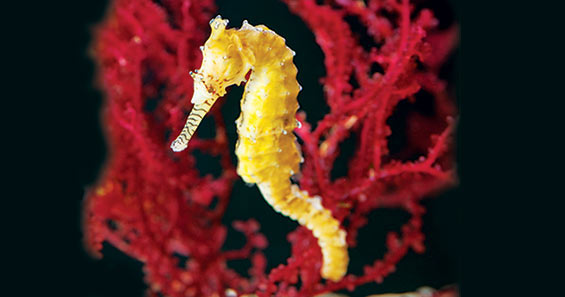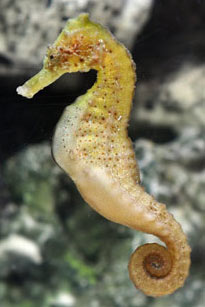
Explore a Unique Fish-Keeping Experience
The Captive-Bred ORA® Kuda Seahorse (Hippocampus kuda) and Barbouri Seahorse (Hippocampus barbouri) are highly social fish that thrive when kept as mated pairs or in small groups in a species-only aquarium. A 30 gallon aquarium is sufficient for a single pair, however, you should add 10 gallons to the size of the aquarium for each additional pair. Spray bars may be used to create gentle flow while eliminating stagnant areas in the aquarium. Seahorses are not strong swimmers, preferring to use their prehensile tails to hitch to branching live rock, algae, or artificial decorations.
Water temperature is one of the most vital aspects of a seahorse setup. Seahorses are less likely to contract Vibrio bacterial infections if the temperature is not allowed to exceed 74°F. This is particularly important if the aquarium contains other species of Syngnathids, so make sure you invest in adequate cooling equipment such as a chiller to maintain the recommended temperature parameters for your seahorse species. It is also necessary to remove detritus and uneaten food daily. Calcium and alkalinity levels must be monitored and maintained to keep their bony plates healthy.

Mister Mom
Perhaps the most intriguing trait about seahorses is how they raise their young. In seahorses, it is the male who is "impregnated" by the female and who is responsible for carrying the fertilized eggs. The males are distinguished by the presence of a brood pouch on the abdomen, which hosts the eggs that the male seahorse receives from the female. Aquarists will delight in the ornate courtship ritual of the seahorse as the male and female dance and change colors while rising to the top of the aquarium. On the descent, the female deposits her eggs into the male's pouch, where they are then fertilized and incubated. After a few weeks on average, live tiny baby seahorses are born.
Do Your Research
The theory that you can take care of seahorses the same way you do other marine fishes is misleading. The truth is, seahorse care is different and arguably more complex. They are prone to different diseases than most other fishes, such as Vibrio bacterial infections, gas bubble disease, and snout rot. In addition, tankmates should be non-aggressive fish that will not out-compete the seahorse for food. Small, shy fish such as small gobies, pipefish, dragonets, and firefish may be kept with Barbouri and Kuda Captive-Bred ORA® Seahorses. However, aggressive, territorial, or fast-moving fish do not make good companions.
Captive-bred Barbouri and Kuda seahorses are accustomed to frozen Mysis shrimp, making them a smart alternative to their wild-caught counterparts. They will also feed upon amphipods and other small crustaceans found in live rock. They will also accept vitamin-enriched adult brine shrimp , but this should not make up a majority of their diet. They are slow, deliberate feeders and prefer two or more small feedings per day.
Seahorses can be harmed by anemones and corals with stinging tentacles or corals that are large enough to consume them, such as brain corals. While sea fans, Acropora corals, and other branching corals may be safe for seahorses, they can be irritated or damaged by a seahorse that continually hitches to them. Crabs and clams may pinch a seahorse causing a wound that could lead to secondary infections. Small ornamental crustaceans may be consumed by the seahorses.
Seahorses are probably the most recognizable fish in the world due to their unusual appearance and habits. They are very social, curious fish that are fun to watch while they interact with their surroundings, each other, and even their owners.
|